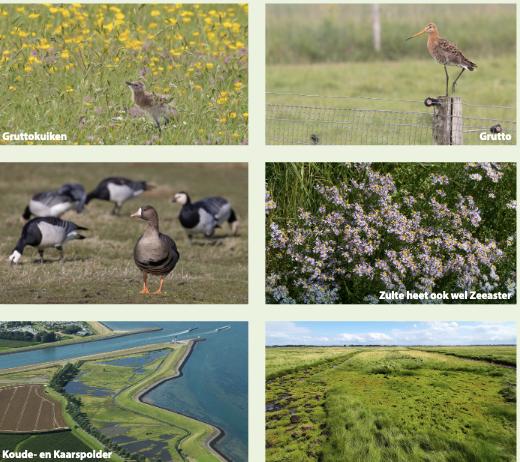Salty and varied
You are standing in one of Zeeland’s most valuable natural and cultural landscapes. Here, under a layer of sea clay, lies a layer of salt marsh peat. Large swaths of peat were dug away until the 15th century, resulting in a bumpy landscape.
Today, that landscape provides an abundance of ecological features: the differences in altitude offer a lot of variation in growing places, some higher, drier and fresher, to some lower, wetter and saltier. The resulting vegetation is extremely varied. The area is home to a wide variety of breeding meadow birds every year, and thousands of geese and ducks travel here in autumn for the winter.
Salt marsh peat and creek ridges
Until about 2,000 years ago, this area was a freshwater marsh that created a thick peat layer. Around 350 AD, the sea flooded the area, drenching the peat with salt and covering it with a layer of clay. Tidal action carved deep creeks into the landscape, which gradually silted up with sand and clay. The peat settled over time, leaving the sandy creek bed relatively higher. Around 800 AD, people started using the dry creek ridges for settlements and roads. After dike construction in the 11th century, the lower areas, where saltwater seep also rose to the surface, were used as grassland.
Salt extraction
Until the 15th century, large-scale peat harvesting (“selnering”) took place here; the salt in the peat was worth a lot of money. So much was dug away in Zeeland that entire villages and the town of Reymerswael were lost to the waves. Where the peat was cut away, the excavated covering layer of clay was thrown back carelessly. This process resulted in Yerseke Moer’s bumpy appearance.

- The black-tailed godwit (Grutto), our national bird, breeds in this area. A special fence protects meadow birds from predators such as foxes.
- Thousands of geese and ducks visit the area in winter.
- Salt-tolerant plants, such as sea aster (Zeeaster, Zulte), thrive in this salty environment.
- The Eastern Scheldt is bordered by 'inlagen' (such as Koude- en Kaarspolder), wetlands between the sea dyke and the sleeper dyke.
- Salty peat and clay in the soil, human excavation: there are signs of it everywhere in the vegetation.
Geopark
The Flemish-Dutch Scheldt Delta is a unique area. The geological genesis, the rich cultural history, and the ongoing struggle between man and water and living with water are tangible everywhere. At the same time, this also makes it one of the most vulnerable areas to climate change. This gives the area all the ingredients for the UNESCO Global Geopark hallmark. More information: www.scheldedelta.eu.
Your visit
The area is not accessible to give breeding birds and wintering birds adequate rest. You have a great view of it from the public roads! The summer trail is open from 15 July to 15 October and leads through part of the area.




